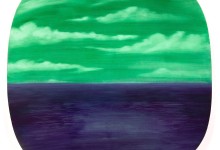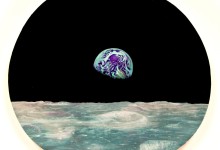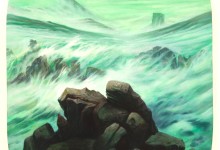Opening reception: Thursday, April 25, 2019 from 5-7 p.m.
Adam Gunn: Island of the Dead
Hessische Str. 9. 10115 Berlin
Text by Adam Gunn
In his book Now or Never naturalist Tim Flannery describes a vision of a world with a dead purple ocean and a poisonous green sky. This is a world where warming has melted the ice caps and slowed down the circulation of the oceans so that they have become like a gigantic stagnant pond. This still oxygen depleted water will allow the proliferation of anoxygenic bacteria that will change the chemistry of the ocean making it poisonous to oxygen dependant life. These bacteria will also release hydrogen sulfide into the atmosphere causing a mass extinction of animal and plant life on land. This stark yet colourful world will be sublimely beautiful, but there will be no one around to see it.
This series of paintings depicts an imagining of our world after the catastrophic consequences of climate change through a reinterpretation of well-known images with a romantic sensibility towards nature. Romanticism was in part a reaction to the industrial revolution marked by a nostalgia for an untouched natural world and a reverence for its overwhelming power. Ironically the spread and continuation of that industrialism is predicted to set in motion a new version of nature that will completely overpower the human world as we know it. With these thoughts in mind, I’ve sourced some paintings associated with the romantic movement and removed the human figures from them – the only evidence of people are the decaying ruins left behind in this uncanny green and purple landscape. I’ve also referenced some photographs from the Apollo moon missions that are thought to have influenced the beginning of modern environmental awareness.
The starting point for this series of paintings was Arnold Böcklin’s Isle of the Dead. This painting of a sinister gloomy island cemetery isolated in vast calm waters has an otherworldliness about it that has an (influential and) enduring appeal. Arnold Böcklin produced five versions of this paining between 1880 and 1901. The third version is housed at the Alte Nationalgalerie in Berlin and was previously owned by Adolf Hitler who hung it in the Reich Chancellery. This disturbing association adds a layer of complication to the painting, and on reflection I found myself thinking about the first German I ever met, a young exchange student at my high-school in Nova Scotia where we shared a philosophy class together. I remember a discussion we had about our grandparents when this girl gave an account of a confrontation she had with hers, asking them, “Why didn’t you do anything?” Will later, and potentially the last, generations of people feel the same way about us?
The artist would like to thank the Joseph Plaskett Foundation for the support that was given through the Nancy Petry Art Award.







